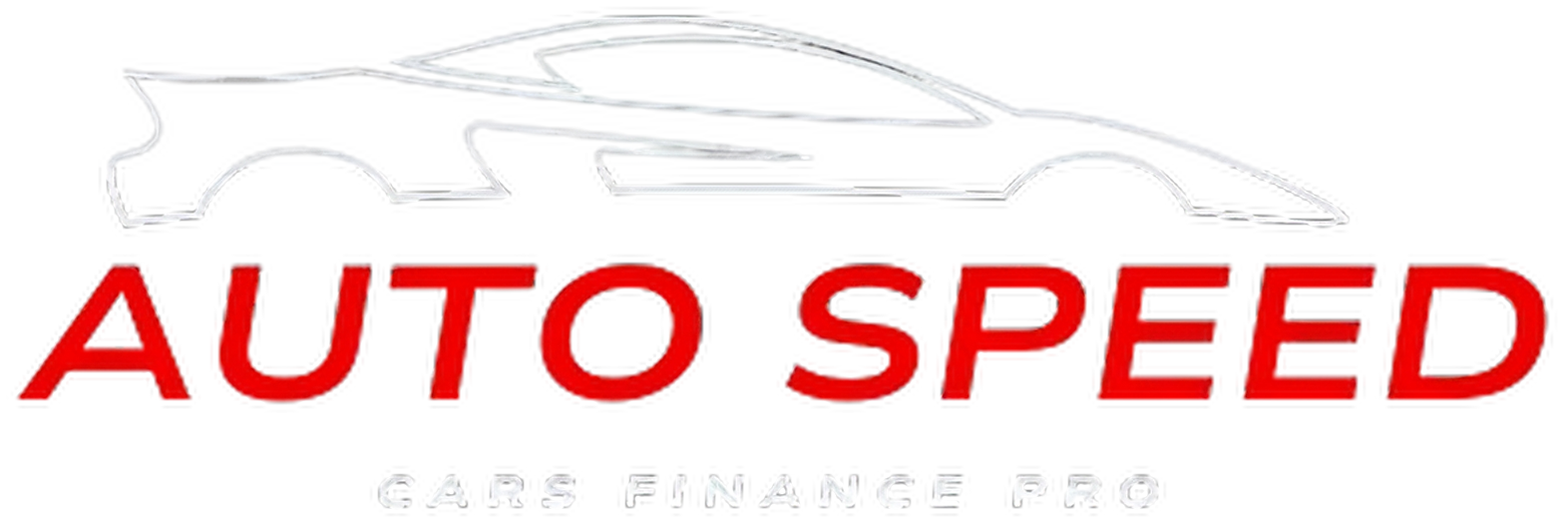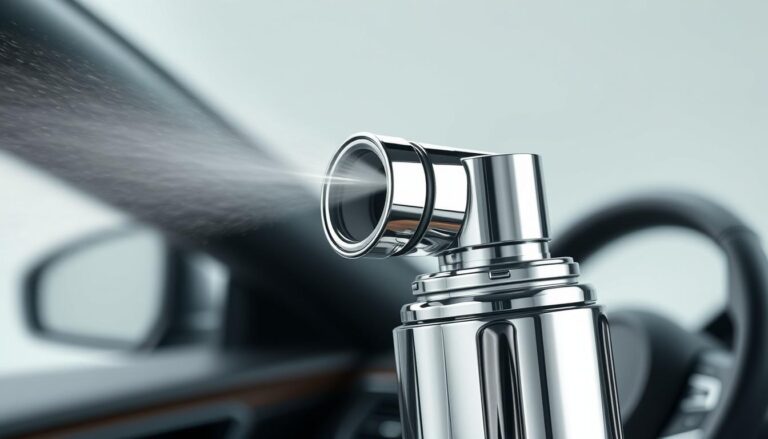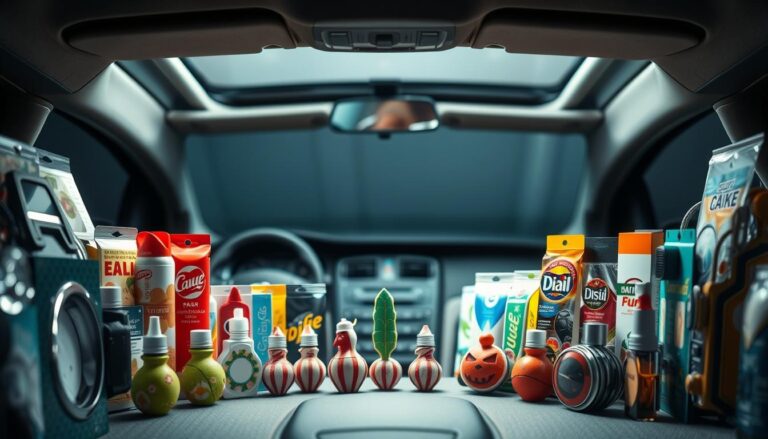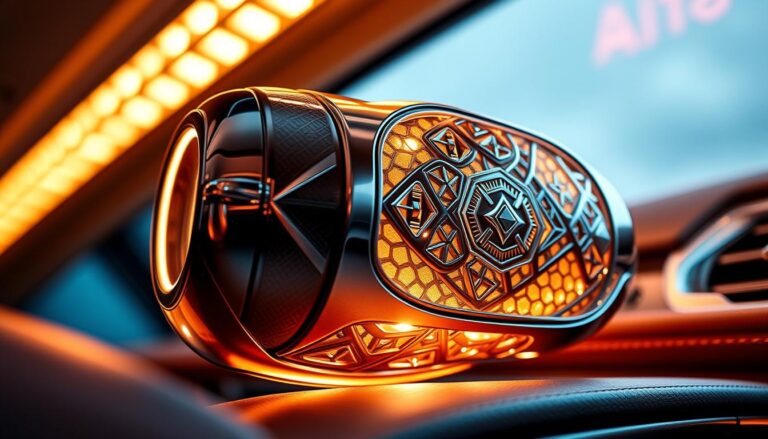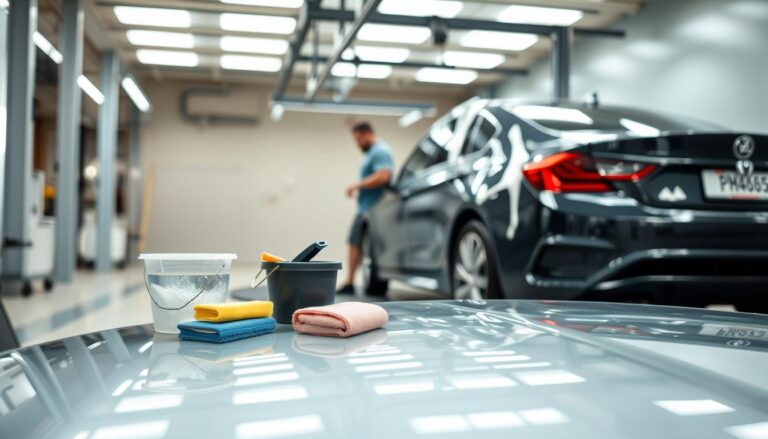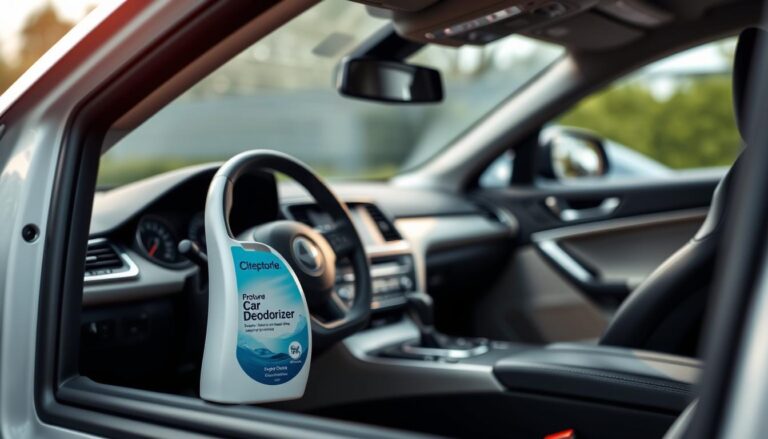What is a Touchless Automatic Car Wash and How Does It Work?
Table of Contents
A touchless automatic car wash uses high-pressure water and cleaning solutions without touching the car. This modern tech replaces brushes with sprayers. It safely removes dirt and grime while protecting the car’s paint and finishes.
These systems are popular for keeping cars looking good. They avoid brushes to prevent scratches. Instead, they use water and eco-friendly chemicals. This section will explain how these innovations work and why they’re changing car care.
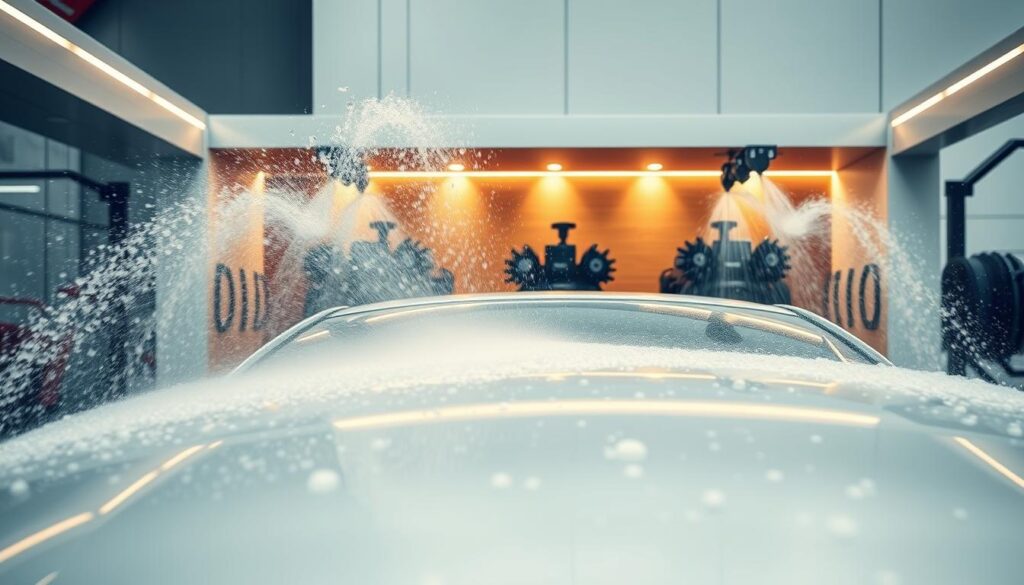
Key Takeaways
- Touchless car washes clean cars without brushes, using water and chemicals.
- Modern car wash technology prioritizes paint protection and resource efficiency.
- These systems minimize water use compared to traditional methods.
- They eliminate contact-based damage common in older brushing techniques.
- Touchless automatic car washes balance convenience with vehicle protection.
Introduction to Touchless Automatic Car Washes
Car care solutions are always getting better, and touchless systems are leading the way. They let drivers clean their cars without touching them, using cool tech instead. Let’s dive into how they started and why they’re so popular.
Definition and Basic Concept
Touchless car washes, or no-contact car wash systems, use high-pressure water jets and green chemicals. They don’t need brushes or hands, so they’re safe for your car’s finish. This way, they keep your car looking new without touching it.
Brief History of Car Wash Evolution
- 1900s: Cars were washed by hand or with simple brushes.
- 1950s: Belt systems and brushes became common.
- 1980s: First touchless washes came out, using water jets.
- 2020s: Now, they use AI and green chemicals.
Why Touchless Systems Are Gaining Popularity
More people like no-contact car wash services because they’re safe and fast. The main reasons are:
- No damage from brushes or abrasives
- Quick service times
- Works well with fancy and sensitive car finishes
Automated car washes are good for the planet and practical, making them a favorite for green drivers.
The Technology Behind Touchless Automatic Car Wash Systems
Modern touchless car wash systems use advanced engineering to clean cars without touching them. At the heart are high-pressure washing systems that use water pressures up to 1,500 PSI to remove dirt. These systems spray recycled water through nozzles around the bay, ensuring a thorough clean without harming surfaces.
Advanced car wash sensors control every step. Motion detectors start the system when a car enters. Laser scanners then measure the car’s size. This info helps adjust the spray to fit the car’s shape, whether it’s a truck, SUV, or motorcycle.
Sensors also watch chemical levels and water flow in real time. This ensures the wash is done right.
Central computers manage all parts of the wash cycle. They control the pre-wash rinse, soap application, and drying stages. New systems can save up to 80% of water compared to old methods. Smart updates keep the systems running efficiently and safely.
Recently, UV-light sanitization modules and eco-friendly detergent dispensers have been added. These upgrades make the systems not only efficient but also good for the environment. They meet EPA guidelines, showing they’re in line with today’s eco-conscious consumers.
How a Touchless Automatic Car Wash Works
Modern touchless car wash systems make cleaning easy and precise. Here’s how the touchless car wash process cleans your car without brushes or contact:
Pre-Wash Preparation
Drivers park in special bays. Sensors check the car’s size and shape. A first rinse gets rid of loose dirt, readying it for deeper cleaning.
This step makes sure the cleaning solution spreads evenly during the automatic car cleaning cycle.
High-Pressure Water Jets
Nozzles spray water at 800–1,200 PSI to remove dirt. The water pressure is just right to clean without scratching. High-pressure car washing systems use special nozzles to clean every part without touching.
Chemical Application Process
Detergents and soaps are turned into a fine mist. These eco-friendly solutions break down grease and grime. A soak time lets the chemicals work before rinsing.
Modern systems use pH-balanced agents to protect clear coats and rubber parts.
Rinsing and Drying Mechanisms
Final rinses use water that won’t leave spots. Drying is done with air blowers or heated nozzles. Here’s a quick overview of each step:
| Phase | Description | Outcome |
|---|---|---|
| Pre-Wash | Rinses and scans vehicle dimensions | Prepares surface for detergents |
| Cleaning | High-pressure jets with chemical misting | Removes embedded dirt and grime |
| Rinse/Dry | Spot-free water and air-drying systems | Streak-free finish without towels |
Each step is automated, reducing human touch and boosting efficiency.
Benefits of Choosing a Touchless Car Wash
Modern drivers want car care that’s safe and effective. Touchless systems offer touchless car wash benefits that traditional methods can’t match. They protect vehicles without using brushes or contact tools, keeping them looking good and valuable. An
Paint and Finish Protection
A paint protection car wash keeps your car safe from damage. It uses high-pressure water and safe cleaners to clean without scratching. This helps keep the paint looking new for longer.
- Preserves the factory finish
- Keeps colors bright for longer
- Works well on all kinds of cars
Reduced Risk of Surface Scratches
Scratch-free vehicle cleaning is a big plus. Brushes can scratch mirrors, antennas, and trim. Touchless systems use spray cleaners to wash away dirt without touching the car. This means:
- No scratches from brushes
- Safer for delicate parts like chrome
- Less chance of paint chipping
Effectiveness for Various Vehicle Types
Touchless systems work for all kinds of cars, from SUVs to compact models. They have adjustable nozzles that fit any car shape. This means:
- Works on SUVs with roof racks
- Cleans pickup beds and spoilers
- Safe for cars with custom parts
Touchless technology is safe and flexible, meeting every driver’s needs without harming their car.
Comparing Touchless vs. Traditional Brush Car Washes
When picking between touchless vs brush car wash systems, safety and cleaning are key. Car wash comparison shows how each method treats your car’s surface.
Touchless systems use high-pressure water and detergents without touching your car. This lowers scratch risks. Brush systems scrub but might leave swirl marks on paint. Soft-touch vs touchless debates often center on what works best for SUVs or trucks versus sedans. Brushes are good at removing mud but need regular upkeep to avoid debris.
- Cleaning Mechanism: Touchless sprays detergent, while brushes physically scrub .
- Water Use: Touchless uses 30-50% less water than traditional methods.
- Time: Touchless takes 3-5 minutes; brushes average 8-10 minutes.
- Cost: Prices range from $8-$15 for touchless vs. $10-$20 for brushes, depending on location.
“For classic cars or new vehicles, touchless minimizes abrasion risks,” says the International Carwash Association. Brushes may damage soft trims or aftermarket accessories.
Opt for touchless for luxury or delicate finishes. Brushes are better for dirty trucks. Think about your car’s needs and local services to pick the best car wash comparison option.
Environmental Impact of Touchless Automatic Car Washes
Modern touchless car wash systems are all about being green. They help keep cars clean and protect the planet. These systems cut down on waste and pollution.
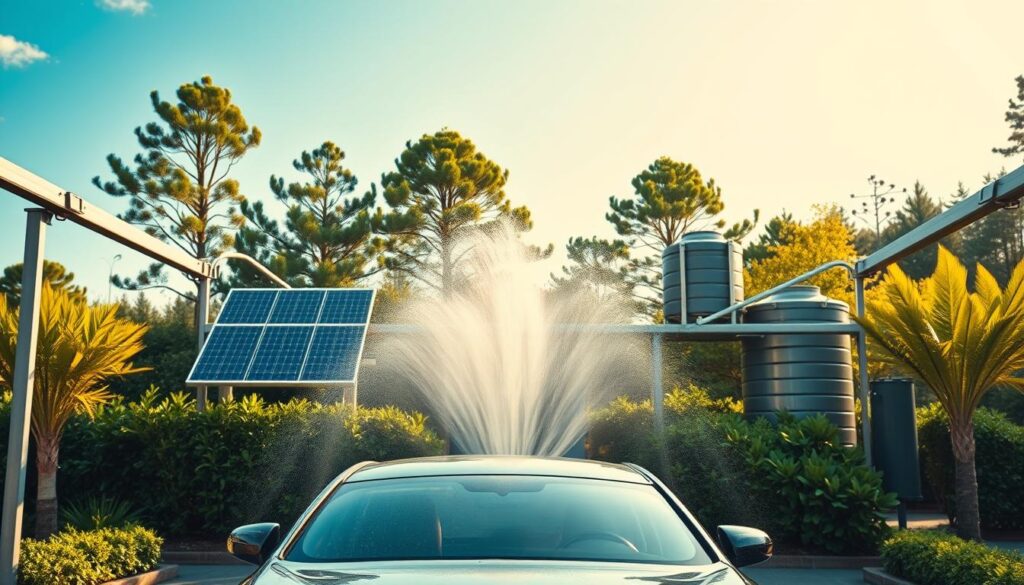
Water Usage and Conservation
Washing your car at home can use up to 100 gallons of water. But, touchless car washes use only 15–30 gallons. Some even recycle up to 90% of water, thanks to special filters.
Many places now use closed-loop systems. This means they use less fresh water and follow EPA rules.
Chemical Formulations and Eco-Friendliness
Touchless car washes use special cleaners that are safe for the environment. EcoClean Solutions makes cleaners from plants, which is better for our waterways. They also don’t use phosphates, which is good for the environment.
Energy Efficiency Considerations
Modern systems save energy in several ways:
- They use high-efficiency pumps that use 30% less electricity.
- Some places, like GreenWash Express, use solar power for blowers.
- They have smart timers that make sure water is used just right.
Some places even use solar panels to make no energy waste.
While DIY car washing is not as green, touchless car washes are getting better. They’re working on using no emissions and biodegradable cleaners. This makes them a top choice for caring for cars in an eco-friendly way.
Cost Analysis: What to Expect at a Touchless Automatic Car Wash
Knowing touchless car wash prices is key for budgeting. Prices for small cars range from $10 to $20. SUVs and trucks can cost up to $25. Prices differ by location, with city areas often more expensive than suburbs or rural areas.
Standard Service Pricing
Prices depend on the car’s size. Compact cars start at $12, sedans at $15, and large trucks at $20. Discounts of 10–20% can be found during off-peak hours or seasons. Brush washes might be cheaper but could damage your paint.
Premium Options and Add-ons
- Wax or sealant treatments: $5–$15 extra
- Undercarriage cleaning: $10–$18
- Interior vacuum services: $10–$20
These premium car wash services offer extra protection. They are worth the extra cost for those who want deep care.
Membership and Loyalty Programs
Many places offer car wash membership plans for regulars. These plans cost $15–$30 a month for unlimited washes. This can save up to 40% over paying each time. Some plans include free extras or points for referrals. Look for deals at places like Valvoline Instant Oil Change or Super Speedy Car Wash.
Finding Quality Touchless Car Wash Facilities Near You
Finding the best touchless car wash for your car is easier with the right tools. Forget generic maps and use sites like WashFinder or AutoWashLocator. They show touchless car wash locations with real reviews.
Apps like SpotHero also help. They give you the latest info on local touchless car wash prices and availability.
When choosing a car wash, focus on three things: equipment, cleaning results, and service. Look for places with certifications from groups like the International Carwash Association. Visit during slow times to see how they handle cars and keep the area clean.
Also, make sure they have clear prices and no hidden costs.
- Check online reviews for mentions of water pressure, chemical smell, and drying effectiveness
- Verify if the facility offers eco-friendly options for chemical and water usage
- Confirm operating hours match your schedule and accessibility for larger vehicles
Pro tip: Try two places nearby to see how they compare. Look for a uniform shine and no streaks. Places that are open about their policies and fees seem more professional. The best touchless car wash spots offer convenience and care for details.
Maintenance Tips for Before and After Using a Touchless Car Wash
To get the most out of a touchless car wash, start with the right prep and care after. Use these car wash preparation tips and vehicle care best practices for lasting results and to protect your car’s finish.
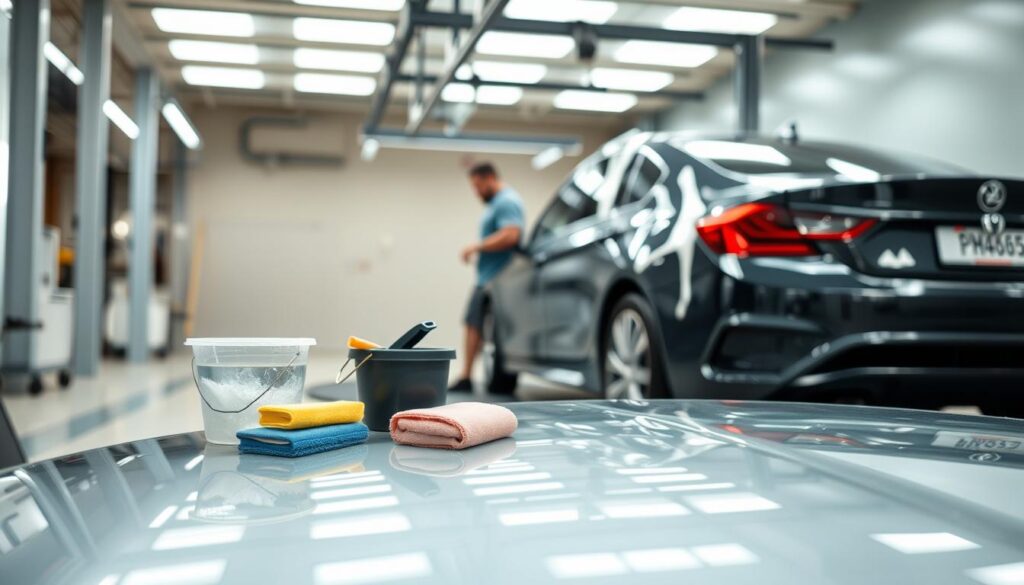
Pre-Wash Vehicle Preparation
First, remove loose stuff like leaves or dried mud. Take off exterior things like antennas or spoilers to stop water from pooling. Make sure door and trunk seals are good to keep water out.
Wipe down dirty spots with a damp cloth to avoid chemical buildup. Wait at least 72 hours after painting or applying coatings before washing.
Post-Wash Care Recommendations
After washing, check for any spots or streaks you missed. Use a microfiber cloth to dry any water left to prevent spots. Put on a good wax 3–5 days after washing to protect the paint.
Do weekly checks for dirt and clean spills right away to avoid stains.
- Pre-Wash Checklist:
- Remove loose dirt and secure loose parts
- Inspect vehicle seals for damage
- Pre-treat heavy dirt spots
- Post-Wash Routine:
- Dry residual water manually
- Apply wax within 3–5 days
- Conduct weekly inspections between washes
By following these steps, your car will stay clean longer and its exterior will last longer. Regular vehicle care best practices make touchless washes a key part of your car care routine.
Common Misconceptions About Touchless Automatic Car Washes
Many drivers wonder how touchless car washes work. This section tackles touchless car wash myths by sharing automatic car wash facts. It aims to clear up car wash misconceptions.
Cleaning Effectiveness: Fact or Myth?
Myth: Touchless can’t clean as well as brushes.
Fact: High-pressure sprays and eco-friendly detergents remove dirt without touching. Studies show they clean effectively for most vehicles.
Water Spots: A Valid Concern?
Myth: Spots are unavoidable after touchless washes.
Fact: Systems use softened water and heated drying to reduce spots. Regular maintenance ensures optimal performance.
Key Misconceptions Explained
| Myth | Fact |
|---|---|
| Chemicals harm paint | Formulations are pH-balanced and safe for all finishes. |
| Pressure causes damage | No physical contact means no scratches. Pressure levels are calibrated for safety. |
| Higher cost than traditional methods | Pricing varies but often matches brush-based options. Long-term benefits like paint protection justify costs. |
These systems balance convenience and performance. Understanding these facts helps drivers make informed choices.
The Future of Touchless Car Wash Technology
Advanced car wash technology is changing the game with car wash innovations. These innovations aim to make car washing more efficient and green. Soon, AI sensors will scan cars to clean them perfectly without touching.
Imagine a car wash that gets every spot right. This is what the future of vehicle cleaning looks like.
- AI contour detection for customized cleaning paths
- IoT integration for real-time equipment monitoring
- Smart water recycling systems cutting usage by up to 40%
Future car washes will use eco-friendly cleaners that break down quickly. They’ll also use solar power and efficient pumps. Some will even use UV light to kill germs, making them safer after the pandemic.
Customers will also see faster drying. New air-drying systems use kinetic energy to dry cars without towels. This saves time and keeps paint safe.
These car wash innovations are all about doing better for cars and the planet. They aim to make every wash better for both cars and the Earth.
Conclusion
Touchless automatic car washes have changed how we take care of our vehicles. They are efficient and protect the car’s finish. This method avoids physical contact and uses less water, making it good for the environment.
These systems are safe for cars and kind to the planet. They work well for all kinds of vehicles. The cost and membership plans fit different needs.
Places like Suds & Shine and AutoSpa Express show how well they work. They prove these car washes are reliable everywhere.
New tech in drying and cleaning products has made them better. They now leave no spots and work well. This is great for those who care about the planet.
Drivers should think about what matters most to them. Do they want to prevent scratches or help the environment? Choosing the right car wash depends on these priorities.
Future improvements will make them even better. They will use less energy and work more automatically. By knowing the benefits of touchless car washes, owners can keep their cars clean and help the environment.
FAQ
What is the primary difference between a touchless automatic car wash and a traditional car wash?
Touchless car washes use high-pressure water jets and special chemicals. They clean cars without touching them. Traditional car washes use brushes or cloths that can scratch the car’s surface.
Are touchless car washes effective in removing tough dirt and grime?
Yes, they are very good at removing dirt and grime. They use high-pressure water jets and special cleaning agents. This way, they clean the car without damaging it.
Is it safe to use a touchless car wash on all types of vehicles?
Most touchless car washes are safe for all vehicles. They don’t use brushes or cloths, so they don’t scratch the car. This makes them safe for cars with special finishes or modifications.
How does the water reclamation system in touchless car washes work?
These systems collect and filter used water. They then reuse it for future washes. This saves water and helps the environment.
Can touchless car washes cause water spots on my vehicle?
Touchless car washes try to avoid water spots. But, if the water has impurities, spots can still happen. Using spot-free rinses or drying options can help prevent spots.
Do touchless car washes use eco-friendly cleaning products?
Many touchless car washes now use eco-friendly products. These products are better for the environment and for aquatic life. This shows they care about sustainability.
What is the typical cost range for a touchless automatic car wash?
Prices range from $10 to $30. This depends on the services, vehicle size, and location. Extra services can increase the cost.
Are there membership or loyalty programs available for touchless car wash services?
Yes, many places offer membership or loyalty programs. These give discounts for regular customers. They often include unlimited washes for a monthly fee.
How can I prepare my vehicle before using a touchless car wash?
Remove loose debris and secure accessories before going. Check door seals for damage. Also, clean heavily soiled areas yourself. This helps the car wash do a better job.
What advancements can we expect in touchless car wash technology in the future?
We might see better nozzle designs and more precise chemical application. There will also be more eco-friendly solutions and automation. AI could help with vehicle detection and monitoring.
